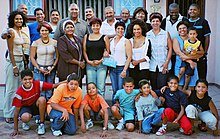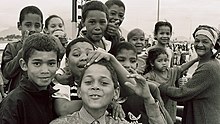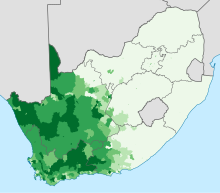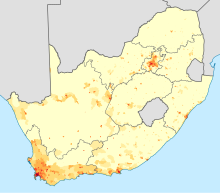Colored


As Coloreds ( Afrikaans : kleurlinge in subordinated use bruin mense or bruin African , German and colored , or mixed race ) is mainly in South Africa - to a lesser extent in Namibia and Zimbabwe indicated a population of highly diverse cultural and ethnic composition -. It is particularly in the area of the former Cape Colony , i. H. in the south and west of South Africa, also distributed in parts of Namibia. There it emerged from the connection between immigrants of European origin and local people, especially Khoikhoi and San , as well as “Cape slaves” from Mozambique , Madagascar , South and Southeast Asia , who assimilated to the European colonial culture .
During apartheid , colored was enshrined as a “racial” category in the Population Registration Act of 1950 and was assigned a middle position between ruling whites and disenfranchised blacks. According to the statistics office, the colored LEDs made up a total of 8.8% of the population of South Africa as of July 2017; in the Western Cape Province , which also includes Cape Town , they are the largest population group with 49%. The majority of colored people in southern Africa speak Afrikaans as their mother tongue.
Historical aspects
Towards the end of the 18th century, a population group that had hitherto barely participated in the public life of the Cape Colony gained numerical importance. It was made up of former slave laborers whose ethnic origins were very mixed, including forcibly imported people from various regions of origin and members of indigenous groups in southern Africa, the Khoikhoi and the San . Since 1834 a school system has been established for this very inhomogeneous population under the umbrella of several mission societies. These schools had a significant influence on the social position at that time and on the development of the self-image of these people. The mission schools supported with public money developed very quickly and had risen to 160 in 1860, in contrast to only 102 schools from the colonial administration. These mission schools were teaching 14,265 students at the time and there were only 4,492 students in the other schools. The Education Act, enacted in 1865, determined state support for three types of school: public schools , mission schools and native schools (literally: native schools ).
Between 1865 and 1921 there was no difference in the educational goals of the mission schools, which would have been specifically differentiated according to the ethnic origin of the students. However, the legislation in 1893 made it possible to set up classes in the mission schools for pupils of European descent. A few years after the founding of the South African Union , a separate section was devoted to school education for people of European and non-European origin in Cape Ordinance No. 5 of 1921. This development led to the introduction of a specific teaching program for Cape Colored primary schools in 1923 .
With regard to the interests of the population group, the Cape Province had set up a Cape Colored Commission , which in its 1937 report made a definition of this population group. Under Prime Minister Jan Smuts , Interior Minister Harry Lawrence ( United Party , later in the PFP ) created the Cape Colored Permanent Commission in 1943 , against which resistance arose among the affected population group. With Ordinance No. 11 from 1945, the authorities of the Cape Province reorganized the school system for children of the Coloreds, which was linked to the introduction of compulsory schooling . From the perspective of the 1955 Tomlinson Commission report, the colored persons population did not show any significant growth from immigration, but was the demographic group with the highest fertility rate between 1936 and 1952 . Nevertheless, since 1951 at the latest, the intention of abolishing the old colored suffrage has spread in nationalist circles, first with the Separation of Voters Act , which was repealed under protests and whose intentions finally became legally binding in 1956. It took until 1969 when the Colored People's Representative Council presented a new offer from the apartheid state for apparently effective participation, which, however, met with little acceptance.
In the days of apartheid which were Coloreds the blacks against the supposedly culturally higher standing and were relatively preferential treatment in this racist society, which was reflected in the settlement policy. When the two suburbs (so-called townships ) Katutura (for black Namibians) and Khomasdal (for colored ) were founded in the then southwest African capital Windhoek at the end of the 1950s , Khomasdal was not only closer to the city, but colored houses were also given there Land.
Even after the end of apartheid politics, the term Colored is still used in South Africa for pragmatic reasons, for example by the state statistics office. For reasons of political correctness , more precise tribal names such as Orlam , Witbooi , Afrikaner and Baster are also used instead .
Demographics and position in civil rights
The group of the South African Coloreds is inhomogeneous in terms of ethnic origin as well as social and religious affiliation. A large group of around 200,000 people form the so-called Cape Malay , which goes back to work slaves from Malaysia who were brought to the Cape Colony by the Dutch and who are mostly Muslim . See also Western Cape Demographics and Cape Town Population Groups .
In the apartheid state, every South African was assigned to a legally defined demographic group, some of which were referred to as “race”. Changes were possible due to special criteria, so that a colored one could be classified as “white” and vice versa.
The position of the Coloreds was connected with concrete legislative consequences during apartheid. Their preference over the black population is reflected in some data collection and identity card provisions in the Population Registration Act of 1950. A special example of the specific treatment of this population group, provided that the people were entitled to vote, are the special regulations of their voting rights with the Separation of Voters Act of 1951. In the three-chamber system of the National Assembly introduced in 1984 , the Coloreds, like the people of Indian origin, each had one chamber, the black majority, however, does not. The House of Representatives of the Colored was ruled by the Labor Party and had little influence. In the run-up to this parliamentary election, massive resistance arose from the two groups of the population, calls for boycotts and criticism because of the intended appropriation for the existing police state. The nationally and internationally widespread pretense of a supposedly democratic procedure in the preparations for the election as well as the planned unequal treatment in the chambers of the Colored and the Indians as well as the consequent exclusion of the black majority from parliamentary participation generated an undreamt-of degree of rejection. Critics such as Neville Alexander described the three-chamber system as an attempt "how to share power without losing control". The consequences for the country were prolonged unrest and the associated states of emergency with police terror against the civilian population. The intended inclusion of the Colored (and the Indians) in and the framework conditions for the elections for the new parliamentary system was condemned by Neville Alexander as a distortion of reality and he called in Cape Town in December 1984 for a critical distance from the press, radio and television ( SABC ) due to countless misrepresentations of events in a variety of influenced media.
In the historically rooted views of South African society and in the demographics formalized by the apartheid policy, coloreds were all those people who could not be clearly assigned to either the ethnic or black population groups. Christoph Marx describes this condition as a definition ex negativo , because neither clear cultural nor biological distinguishing features could be given for it. The term “Colored” found a practice in South Africa with the reservation formulation “so-called” or even in quotation marks. Because declarations of reservations of any kind are understandably unreasonable for those affected, an attitude has now developed in the self-image of the Colored, which they understand as a positive commitment to this group designation.
According to the results of the 2001 census, around four million South Africans belonged to the population group of the Coloreds , which corresponded to a share of 8.9% of the total population of South Africa. In the provinces of the Western Cape and Northern Cape their share was more than 50%, in all other provinces it was well below 10% (between 0.2% in Limpopo and 7.4% in the Eastern Cape ). 79.5% said they spoke Afrikaans as their first language, 18.9% mentioned English.
See also
literature
- Mohamed Adhikari: Not White Enough, Not Black Enough. Racial Identity in the South African Colored Community. Ohio University Press, Athens 2005.
- Jim Hoagl: S. Africa's Coloreds: 'Your Own Dog Bites You the Hardest. In: Washington Post , January 15, 1977 (English)
Individual evidence
- ^ Mohamed Adhikari: Not White Enough, Not Black Enough: Racial Identity in the South African Colored Community. Ohio University Press, Athens, 2005, p. 11.
- ↑ a b c d P. AW Cook: Non-European Education . In: Ellen Hellmann , Leah Abrahams (Ed.): Handbook on Race Relations in South Africa . Cape Town, London, New York, Oxford University Press, 1949, pp. 348-350
- ↑ Mohamed Adhikari: Not White Enough, Not Black Enough. 2005, p. 2.
- ↑ Nelson Mandela Center of Memory and Dialogue: Population Registration Act No 30 . at www.nelsonmandela.org, brief description of the law
- ↑ SAIRR : South Africa Survey 2018 . Johannesburg 2018, p. 10
- ↑ Cape Times: The Colored Commission . Newspaper article from March 11, 1943 in the Cape Times. online at www.historicalpapers.wits.ac.za (English)
- ↑ WWM Eiselen , FR Tomlinson et al .: Summary of the Report of the Commission for Socio-Economic Development of the Bantu Areas within the Union of South Africa . Pretoria, The Government Printer, 1955, pp. 25-26
- ^ René de Villiers: South Africans Politics: The Rising Tide of Color . In: Ellen Hellmann , Henry Lever: Conflict and Progress. Fifty Years of Race Relations in South Africa . Macmillan South Africa Publishers, Johannesburg 1979, pp. 44-45. ISBN 0-86954-078-5
- ↑ Statistics South Africa : Statistical release (Revised), Census 2011 . Pretoria 2012. on www.statssa.gov.za, PDF document p. 21 Overview of the population of South Africa in four population groups between 1996 and 2011, broken down by provinces (English; PDF; 2.71 MB)
- ↑ Information on the classification according to "race" ( Memento from April 23, 2012 in the Internet Archive ) (English), accessed on June 24, 2012
- ^ Neville Alexander : Who sows the wind will reap the storm. Culture and politics of the oppressed majority in South Africa . isp publishing house, Frankfurt a. M. 1986, pp. 150–152 (translated from English: Rainer Gahr, Paul Kleiser, Bernt Lampe, Dorothee Luther)
- ^ Christoph Marx : South Africa. Past and present . Verlag W. Kohlhammer , Stuttgart 2012, p. 225
- ↑ from 2001 (PDF; 624 kB) ( Memento from May 18, 2012 in the Internet Archive ), p. 10.
- ↑ 2001 census (PDF; 624 kB) ( Memento of May 18, 2012 in the Internet Archive ), p. 13.
- ↑ 2001 census (PDF; 624 kB) ( Memento of May 18, 2012 in the Internet Archive ), p. 12.
- ↑ 2001 census (PDF; 624 kB) ( Memento of May 18, 2012 in the Internet Archive ), p. 19.

